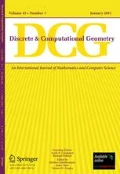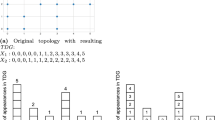Abstract
We investigate what computational tasks can be performed on a point set in \({\mathbb {R}}^d\), if we are only given black-box access to it via nearest-neighbor search. This is a reasonable assumption if the underlying point set is either provided implicitly, or it is stored in a data structure that can answer such queries. In particular, we show the following:
-
(A)
One can compute an approximate bi-criteria k-center clustering of the point set, and more generally compute a greedy permutation of the point set.
-
(B)
One can decide if a query point is (approximately) inside the convex-hull of the point set.
We also investigate the problem of clustering the given point set, such that meaningful proximity queries can be carried out on the centers of the clusters, instead of the whole point set.








Similar content being viewed by others
References
Andersson, L.-E., Stewart, N.F.: Introduction to the Mathematics of Subdivision Surfaces. SIAM, Philadelphia (2010)
Barman, S.: Approximating nash equilibria and dense bipartite subgraphs via an approximate version of Caratheodory’s theorem. In: Proceedings of 47th Annual Symposium on the Theory of Computing (STOC), pp. 361–369 (2015)
Basu, S., Pollack, R., Roy, M.F.: Algorithms in Real Algebraic Geometry. Algorithms and Computation in Mathematics. Springer, Berlin (2006)
Binnig, G., Quate, C.F., Gerber, Ch.: Atomic force microscope. Phys. Rev. Lett. 56, 930–933 (1986)
Blinn, J.F.: A generalization of algebraic surface drawing. ACM Trans. Graph. 1, 235–256 (1982)
Boissonnat, J.-D., Guibas, L.J., Oudot, S.: Learning smooth shapes by probing. Comput. Geom. Theory Appl. 37(1), 38–58 (2007)
Clarkson, K.L.: Coresets, sparse greedy approximation, and the Frank–Wolfe algorithm. ACM Trans. Algorithms 6(4), 63 (2010)
Cole, R., Yap, C.K.: Shape from probing. J. Algorithms 8(1), 19–38 (1987)
Feder, T., Greene, D. H.: Optimal algorithms for approximate clustering. In: Proceedings of 20th Annual ACM Aymposium on Theory of computing (STOC), pp. 434–444 (1988)
Goel, A., Indyk, P., Varadarajan, K. R.: Reductions among high dimensional proximity problems. In: Proceedings of 12th ACM–SIAM Symposium on Discrete Algorithms (SODA), pp. 769–778, (2001)
Gonzalez, T.: Clustering to minimize the maximum intercluster distance. Theor. Comput. Sci. 38, 293–306 (1985)
Har-Peled, S.: Geometric Approximation Algorithms. Mathematical Surveys and Monographs, vol. 173. American Mathematical Society, Providence (2011)
Har-Peled, S., Indyk, P., Motwani, R.: Approximate nearest neighbors: towards removing the curse of dimensionality. Theory Comput. 8, 321–350 (2012). Special issue in honor of Rajeev Motwani
Har-Peled, S., Kumar, N., Mount, D., Raichel, B.: Space exploration via proximity search. CoRR, http://arxiv.org/abs/1412.1398 (2014)
Har-Peled, S., Mendel, M.: Fast construction of nets in low dimensional metrics, and their applications. SIAM J. Comput. 35(5), 1148–1184 (2006)
Indyk, P.: Nearest neighbors in high-dimensional spaces. In: Goodman, J.E., O’Rourke, J. (eds.) Handbook of Discrete and Computational Geometry, Chapter 39, 2nd edn, pp. 877–892. CRC Press, Boca Raton (2004)
Kalantari, B.: A characterization theorem and an algorithm for a convex hull problem. Ann. Oper. Res. 226(1), 301–349 (2015)
Mandelbrot, B.B.: The Fractal Geometry of Nature. Macmillan, New York (1983)
Matoušek, J., Seidel, R., Welzl, E.: How to net a lot with little: small \(\varepsilon \)-nets for disks and halfspaces. In: Proceedings of 6th Annual ACM Symposium on Computational Geometry (SoCG), pp. 16–22 (1990)
Mulvey, J.M., Beck, M.P.: Solving capacitated clustering problems. Eur. J. Oper. Res. 18, 339–348 (1984)
Novikoff, A.B.J.: On convergence proofs on perceptrons. Proc. Symp. Math. Theo. Automata 12, 615–622 (1962)
Panahi, F., Adler, A., van der Stappen, A. F., Goldberg, K.: An efficient proximity probing algorithm for metrology. In: Proceedings of IEEE International Conference on Automation Science and Engineering (CASE), pp. 342–349 (2013)
Smelik, R. M., De Kraker, K. J., Groenewegen, S. A., Tutenel, T., Bidarra, R.: A survey of procedural methods for terrain modelling. In: Proceedings of the CASA. Workshop on 3D Advanced Media In Gaming and Simulation (2009)
Skiena, S.S.: Problems in geometric probing. Algorithmica 4, 599–605 (1989)
Skiena, S.S.: Geometric reconstruction problems. In: Goodman, J.E., O’Rourke, J. (eds.) Handbook of Discrete and Computational Geometry, Chapter 26, pp. 481–490. CRC Press LLC, Boca Raton (1997)
Wikipedia. Atomic force microscopy—Wikipedia, The Free Encyclopedia (2014)
Acknowledgments
N.K. would like to thank Anil Gannepalli for telling him about Atomic Force Microscopy. The full paper is available online [14]. Work on this paper by S. Har-Peled was partially supported by NSF AF Awards CCF-1421231, and CCF-1217462. Work on this paper by N. Kumar was partially supported by a NSF AF Award CCF-1217462 while the author was a student at UIUC, and by NSF Grant CCF-1161495 and a grant from DARPA while the author has been a postdoc at UCSB. Work on this paper by D. M. Mount was partially supported by NSF Award CCF-1117259 and ONR Award N00014-08-1-1015. Work on this paper by B. Raichel was partially supported by NSF AF Awards CCF-1421231, CCF-1217462, and the University of Illinois Graduate College Dissertation Completion Fellowship.
Author information
Authors and Affiliations
Corresponding author
Additional information
Editor in Charge: Kenneth Clarkson
Rights and permissions
About this article
Cite this article
Har-Peled, S., Kumar, N., Mount, D.M. et al. Space Exploration via Proximity Search. Discrete Comput Geom 56, 357–376 (2016). https://doi.org/10.1007/s00454-016-9801-7
Received:
Revised:
Accepted:
Published:
Issue Date:
DOI: https://doi.org/10.1007/s00454-016-9801-7




